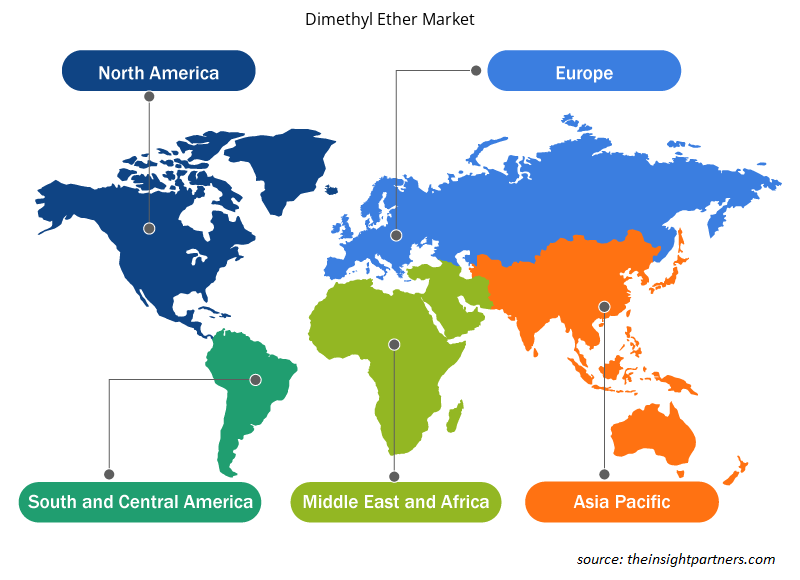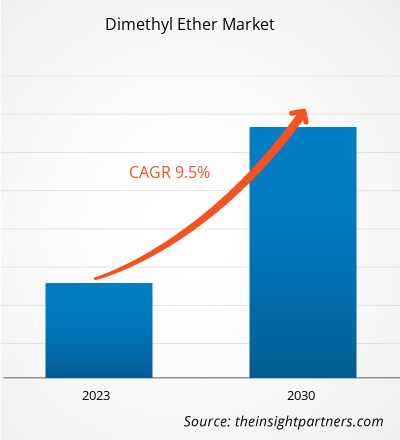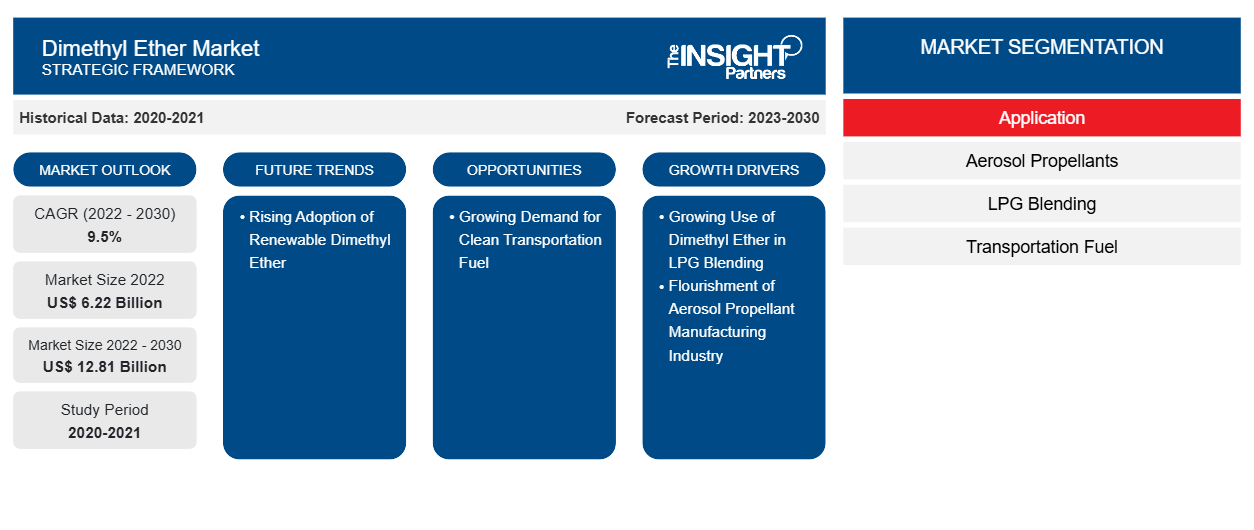[Rapporto di ricerca] Il mercato dell'etere dimetilico è stato valutato a 6.216,45 milioni di dollari nel 2022 e si prevede che raggiungerà 12.808,32 milioni di dollari entro il 2030; si stima che registrerà un CAGR del 9,5% dal 2022 al 2030.
Approfondimenti di mercato e opinioni degli analisti:
Il dimetiletere è un gas incolore e infiammabile a temperatura e pressione ambiente. Viene utilizzato principalmente come propellente negli spray aerosol e come componente di miscelazione nel GPL. Il mercato del dimetiletere ha subito significative trasformazioni negli ultimi anni, spinte dalle sue applicazioni versatili e dalle sue proprietà ecocompatibili. In risposta alle preoccupazioni globali sulla qualità dell'aria e sulle emissioni di gas serra, il dimetiletere è emerso come un candidato promettente per sostituire il tradizionale carburante diesel. Questo cambiamento si verifica in particolare nelle regioni in cui la riduzione delle emissioni dei motori diesel è una priorità assoluta. Quando brucia, il dimetiletere produce emissioni significativamente inferiori, in particolare di particolato, rispetto ai carburanti diesel convenzionali. Di conseguenza, il dimetiletere ha attirato l'attenzione come opzione di carburante a combustione più pulita che si allinea con gli obiettivi di sostenibilità e i requisiti normativi. Inoltre, il dimetiletere può essere prodotto da una varietà di materie prime, tra cui gas naturale, carbone e biomassa. Questa adattabilità nelle fonti di materie prime aumenta il suo fascino come soluzione energetica rinnovabile e sostenibile e si prevede che guiderà la crescita del mercato del dimetiletere.
Fattori di crescita e sfide:
La compatibilità di DME e GPL rende la miscelazione un processo fluido. Il DME ha proprietà fisiche simili al GPL, come essere gassoso a temperatura ambiente e facilmente liquefatto a pressione moderata. Questa compatibilità garantisce che le miscele DME-GPL possano essere immagazzinate, trasportate e distribuite utilizzando l'infrastruttura GPL esistente, come serbatoi di stoccaggio, reti di distribuzione e stazioni di rifornimento. Questo aspetto riduce significativamente le barriere all'ingresso per l'adozione di miscele DME-GPL e consente un'integrazione più rapida nei sistemi energetici esistenti. Le miscele DME-GPL offrono una soluzione transitoria poiché le industrie e i governi cercano di diversificare le loro fonti energetiche e ridurre la dipendenza dai combustibili fossili tradizionali. La crescente consapevolezza riguardo ai vantaggi delle miscele DME-GPL promuove un panorama energetico più sostenibile ed efficiente, guidando così la crescita del mercato dell'etere dimetilico.
Tuttavia, la presenza di potenziali sostituti come il gas naturale compresso (CNG) e l'etanolo potrebbe limitare la crescita del mercato del dimetiletere. Grazie al suo profilo di emissioni più basso, il CNG è ampiamente utilizzato come alternativa alla benzina convenzionale e ai carburanti diesel nel settore dei trasporti. Come il DME, il CNG offre emissioni di gas serra e inquinanti atmosferici ridotti rispetto ai combustibili fossili tradizionali. Questa sovrapposizione di vantaggi potrebbe portare alla concorrenza tra DME e CNG, soprattutto nelle regioni con infrastrutture CNG ben sviluppate. Inoltre, l'etanolo è un altro sostituto che potrebbe avere un impatto sul mercato del dimetiletere, in particolare in termini di utilizzo come carburante alternativo e ossigenato nella benzina. L'etanolo derivato da fonti rinnovabili, come biomassa e materie prime agricole, ha attirato l'attenzione come carburante alternativo più pulito. Pertanto, la disponibilità di prodotti sostitutivi potrebbe avere un impatto negativo sulla crescita del mercato del dimetiletere.
Personalizza questo report in base alle tue esigenze
Riceverai la personalizzazione gratuita di qualsiasi report, comprese parti di questo report, o analisi a livello nazionale, pacchetto dati Excel, oltre a usufruire di grandi offerte e sconti per start-up e università
- Scopri le principali tendenze di mercato in questo rapporto.Questo campione GRATUITO includerà analisi di dati che spaziano dalle tendenze di mercato alle stime e alle previsioni.
Segmentazione e ambito del report:
Il mercato globale del dimetiletere è segmentato in base all'applicazione e alla geografia. In base all'applicazione, il mercato del dimetiletere è segmentato in propellenti per aerosol, miscelazione di GPL, carburante per trasporti, carburante per la generazione di energia, materie prime chimiche e altri. In base alla geografia, il mercato del dimetiletere è segmentato in Nord America (Stati Uniti, Canada e Messico), Europa (Germania, Francia, Italia, Regno Unito, Russia e resto d'Europa), Asia Pacifico (Australia, Cina, Giappone, India, Corea del Sud e resto dell'Asia Pacifico), Medio Oriente e Africa (Sudafrica, Arabia Saudita, Emirati Arabi Uniti e resto del Medio Oriente e Africa) e Sud e Centro America (Brasile, Argentina e resto del Sud e Centro America).
Analisi segmentale:
In base all'applicazione, il mercato del dimetiletere è segmentato in propellenti per aerosol, miscelazione di GPL, carburante per trasporti, carburante per la generazione di energia, materie prime chimiche e altri. Si prevede che il segmento del carburante per trasporti registrerà una crescita significativa dal 2022 al 2030. Mentre governi, industrie e consumatori in tutto il mondo danno sempre più priorità alla sostenibilità ambientale e cercano alternative ai combustibili fossili convenzionali, il DME emerge come un candidato promettente grazie alle sue proprietà uniche e alla compatibilità con le esigenze di trasporto pulito. Uno dei principali fattori trainanti alla base della domanda di carburanti per trasporti puliti è l'urgente necessità di ridurre le emissioni di gas serra e gli inquinanti atmosferici. I carburanti diesel convenzionali contribuiscono all'inquinamento atmosferico e sono una fonte considerevole di emissioni di anidride carbonica . Il DME, d'altro canto, offre diversi vantaggi ambientali. Produce emissioni di particolato, anidride solforosa e ossidi di azoto inferiori rispetto alle tradizionali fonti di emissioni di anidride carbonica. Il DME, d'altro canto, offre diversi vantaggi ambientali. Produce emissioni di particolato, anidride solforosa e ossidi di azoto inferiori rispetto al diesel tradizionale. Inoltre, la combustione di DME genera meno gas serra, contribuendo a una qualità dell'aria più pulita e a un futuro più sostenibile. I carburanti per il trasporto puliti come il DME si allineano bene con la spinta globale per soddisfare gli obiettivi di riduzione delle emissioni definiti in accordi internazionali come l'Accordo di Parigi. I governi stanno implementando normative più severe per limitare le emissioni dei veicoli, fornendo un ambiente favorevole per l'adozione di carburanti più puliti. Poiché il DME può essere facilmente integrato nei motori diesel esistenti con modifiche minime, fornisce una soluzione interessante per le industrie che cercano una riduzione immediata delle emissioni con ampi cambiamenti infrastrutturali. Tutti questi fattori stanno guidando la crescita del segmento dei carburanti per il trasporto nel mercato dell'etere dimetilico.dimethyl ether market is segmented into aerosol propellants, LPG blending, transportation fuel, power generation fuel, chemical feedstock, and others. The transportation fuel segment is expected to register significant growth from 2022 to 2030. As governments, industries, and consumers worldwide increasingly prioritize environmental sustainability and seek alternatives to conventional fossil fuels, DME emerges as a promising candidate due to its unique properties and compatibility with clean transportation needs. One of the key drivers behind the demand for clean transportation fuels is the urgent requirement to lessen greenhouse gas emissions and air pollutants. Conventional diesel fuels contribute to air pollution and are a considerable source of DME, on the other hand, offers several environmental advantages. It produces lower particulate matter emissions, DME, on the other hand, offers several environmental advantages. It produces lower particulate matter emissions, sulfur dioxide, and nitrogen oxides than traditional diesel. Moreover, DME combustion generates fewer greenhouse gases, contributing to cleaner air quality and a more sustainable future. Clean transportation fuels such as DME align well with the global push to meet emission reduction targets defined in international agreements such as the Paris Agreement. Governments are implementing stricter regulations to curb vehicle emissions, providing a favorable environment for the adoption of cleaner fuels. As DME can be easily integrated into existing diesel engines with minimal modifications, it provides an attractive solution for industries seeking immediate emissions reduction with extensive infrastructural changes. All these factors are driving the growth of the transportation fuel segment in the dimethyl ether market.
Analisi regionale:
In base alla geografia, il mercato dell'etere dimetilico è suddiviso in cinque regioni chiave: Nord America, Europa, Asia Pacifico, America meridionale e centrale e Medio Oriente e Africa. Si stima che la regione Asia Pacifico si aggiri intorno a circa 1.000 milioni di $ USA nel 2022. La regione è diventata un polo manifatturiero globale, con settori che spaziano da prodotti chimici, GPL, propellenti per aerosol alla produzione di energia. L'attenzione del governo sulla sostituzione delle fonti di combustibile tradizionali con fonti alternative può offrire potenziali opportunità nel mercato dell'etere dimetilico. Pertanto, con il progredire e l'industrializzazione della regione, si prevede che la domanda di etere dimetilico rimarrà forte, il che dovrebbe aumentare la crescita del mercato dell'etere dimetilico nell'Asia Pacifico dal 2022 al 2030. Si prevede che l'Europa registrerà un CAGR di circa il 9% dal 2022 al 2030. Gli obiettivi di sostenibilità dell'Europa e la transizione verso fonti di energia pulita hanno spinto i produttori a produrre DME da materie prime rinnovabili. Nel 2021, SHV Energy e UGI International hanno ricevuto l'approvazione dalla Commissione Europea per costituire una joint venture per produrre e utilizzare dimetiletere rinnovabile. Tutti questi fattori stanno guidando la crescita del mercato del dimetiletere in Europa. Inoltre, si prevede che il Nord America sarà valutato a circa 4.000 milioni di dollari nel 2030.
Sviluppi del settore e opportunità future:
Di seguito sono elencate le varie iniziative intraprese dai principali attori che operano nel mercato dell'etere dimetilico:
- A gennaio 2021, Mitsubishi Corp ha avviato le operazioni commerciali presso il suo impianto di metanolo e dimetiletere (DME) a Trinidad e Tobago. L'impianto ha una capacità produttiva annuale di 1 milione di tonnellate di metanolo e 20.000 tonnellate metriche di DME. L'impianto ha iniziato a funzionare commercialmente il 18 dicembre 2020. L'impianto è gestito da Caribbean Gas Chemical Ltd (CGCL).
- Nel maggio 2021, Oberon Fuels, produttore di carburante per il trasporto a base di dimetiletere (DME) a combustione pulita, ha avviato negli Stati Uniti la produzione di DME rinnovabile (rDME), l'unica produzione commerciale attuale.
Approfondimenti regionali sul mercato dell'etere dimetilico
Le tendenze regionali e i fattori che influenzano il mercato del dimetiletere durante il periodo di previsione sono stati ampiamente spiegati dagli analisti di Insight Partners. Questa sezione discute anche i segmenti e la geografia del mercato del dimetiletere in Nord America, Europa, Asia Pacifico, Medio Oriente e Africa e Sud e Centro America.

- Ottieni i dati specifici regionali per il mercato dell'etere dimetilico
Ambito del rapporto di mercato dell'etere dimetilico
| Attributo del report | Dettagli |
|---|---|
| Dimensioni del mercato nel 2022 | 6,22 miliardi di dollari USA |
| Dimensioni del mercato entro il 2030 | 12,81 miliardi di dollari USA |
| CAGR globale (2022-2030) | 9,5% |
| Dati storici | 2020-2021 |
| Periodo di previsione | 2023-2030 |
| Segmenti coperti | Per applicazione
|
| Regioni e Paesi coperti | America del Nord
|
| Leader di mercato e profili aziendali chiave |
|
Densità dei giocatori del mercato dell'etere dimetilico: comprendere il suo impatto sulle dinamiche aziendali
Il mercato del Dimethyl Ether Market sta crescendo rapidamente, spinto dalla crescente domanda degli utenti finali dovuta a fattori quali l'evoluzione delle preferenze dei consumatori, i progressi tecnologici e una maggiore consapevolezza dei benefici del prodotto. Con l'aumento della domanda, le aziende stanno ampliando le loro offerte, innovando per soddisfare le esigenze dei consumatori e capitalizzando sulle tendenze emergenti, il che alimenta ulteriormente la crescita del mercato.
La densità degli operatori di mercato si riferisce alla distribuzione di aziende o società che operano in un particolare mercato o settore. Indica quanti concorrenti (operatori di mercato) sono presenti in un dato spazio di mercato in relazione alle sue dimensioni o al valore di mercato totale.
Le principali aziende che operano nel mercato dell'etere dimetilico sono:
- Società per azioni Nouryon Chemicals Holding BV
- Società per azioni Shell
- Mitsubishi Gas Chemical Co Inc
- La Chemours Co.
- Aerosolex
Disclaimer : le aziende elencate sopra non sono classificate secondo un ordine particolare.

- Ottieni una panoramica dei principali attori del mercato dell'etere dimetilico
Impatto del COVID-19:
La pandemia di COVID-19 ha avuto effetti negativi su quasi tutti i settori in vari paesi. I lockdown, le restrizioni di viaggio e le chiusure aziendali in Nord America, Europa, Asia Pacifico (APAC), Sud e Centro America e Medio Oriente e Africa (MEA) hanno ostacolato la crescita di diversi settori, tra cui l'industria chimica e dei materiali. La chiusura delle unità produttive delle aziende di dimetiletere ha disturbato le catene di fornitura globali, le attività di produzione e i programmi di consegna. Diverse aziende hanno segnalato ritardi nelle consegne dei prodotti e un crollo delle vendite dei loro prodotti nel 2020. La maggior parte degli impianti di produzione industriale è stata chiusa durante la pandemia, riducendo il consumo di dimetiletere. Inoltre, la pandemia di COVID-19 ha causato fluttuazioni nei prezzi del dimetiletere. Tuttavia, vari settori hanno ripreso le loro attività dopo che i vincoli di fornitura sono stati risolti, il che ha portato a una ripresa del mercato del dimetiletere. Inoltre, la crescente domanda di dimetiletere da parte di settori applicativi come la miscelazione di GPL, i propellenti per aerosol e i prodotti chimici sta promuovendo sostanzialmente la crescita del mercato del dimetiletere.
Scenario competitivo e aziende chiave:
Nouryon Chemicals Holding BV, Shell Plc, Mitsubishi Gas Chemical Co Inc, The Chemours Co, Aerosolex, Oberon Fuels Inc, Merck KGaA, Jiangsu July Chemical Co Ltd, Sichuan Lutianhua Co Ltd e Grillo-Werke AG sono tra i player che operano nel mercato globale del dimetiletere. I player del mercato globale del dimetiletere si concentrano sulla fornitura di prodotti di alta qualità per soddisfare la domanda dei clienti.
- Analisi storica (2 anni), anno base, previsione (7 anni) con CAGR
- Analisi PEST e SWOT
- Valore/volume delle dimensioni del mercato - Globale, Regionale, Nazionale
- Industria e panorama competitivo
- Set di dati Excel
Report recenti
Testimonianze
Motivo dell'acquisto
- Processo decisionale informato
- Comprensione delle dinamiche di mercato
- Analisi competitiva
- Analisi dei clienti
- Previsioni di mercato
- Mitigazione del rischio
- Pianificazione strategica
- Giustificazione degli investimenti
- Identificazione dei mercati emergenti
- Miglioramento delle strategie di marketing
- Aumento dell'efficienza operativa
- Allineamento alle tendenze normative





















 Ottieni un campione gratuito per - Mercato dell'etere dimetilico
Ottieni un campione gratuito per - Mercato dell'etere dimetilico